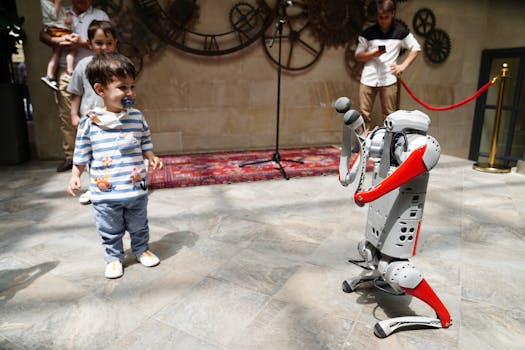
**
Nvidia, the undisputed king of AI chips, has its sights set on a new frontier: robotics. CEO Jensen Huang recently declared that robotics represents Nvidia's biggest opportunity after the explosive growth of artificial intelligence. This bold statement sends ripples throughout the tech industry, signaling a potential paradigm shift in the robotics sector and highlighting the crucial role of advanced computing power in its future development. This article delves into Huang’s comments, exploring the implications for the robotics industry, the technologies driving this transformation, and the opportunities and challenges that lie ahead.
Nvidia's Robotics Ambitions: Beyond AI
Nvidia's success in the AI revolution, fueled by its powerful GPUs (Graphics Processing Units) and CUDA parallel computing platform, is well documented. The company's chips power everything from large language models like ChatGPT to the sophisticated AI behind self-driving cars. But Huang's vision extends beyond AI's current applications. He sees robotics as the next logical step, a domain ripe for disruption by Nvidia's advanced computing capabilities. This isn’t merely an expansion of existing markets; it’s a leap into a vastly larger and more complex ecosystem.
The Convergence of AI and Robotics
Huang's prediction isn't unfounded. The advancements in artificial intelligence are directly fueling the evolution of robotics. AI algorithms power the perception, decision-making, and control systems of robots, allowing them to navigate complex environments, interact with humans, and perform increasingly sophisticated tasks. This convergence is particularly evident in several key areas:
Computer Vision: Nvidia's GPUs are instrumental in processing the vast amounts of visual data that robots need to understand their surroundings. Improved computer vision algorithms, powered by Nvidia's hardware, enable robots to "see" and interpret their environment with greater accuracy and speed. This is critical for applications like autonomous mobile robots (AMRs) in warehouses and autonomous vehicles.
Deep Learning: Deep learning models, trained on massive datasets using Nvidia's hardware, allow robots to learn complex behaviors and adapt to new situations. This is crucial for tasks requiring flexibility and adaptability, such as object manipulation, human-robot collaboration, and navigating unpredictable environments.
Sensor Fusion: Modern robots use a variety of sensors – cameras, lidar, radar, and IMUs – to gather data about their surroundings. Nvidia's platforms are essential for processing and integrating data from these diverse sources, creating a comprehensive understanding of the robot's environment. This improved sensor fusion leads to more reliable and robust robot performance.
Edge AI: Processing data directly on the robot, rather than relying on cloud connections, is crucial for real-time responsiveness and reduced latency. Nvidia's Jetson platform, a family of embedded systems optimized for AI, is key to enabling edge AI in robotics applications, empowering robots with greater autonomy and speed.
The Market Opportunity: A Multi-Trillion Dollar Sector
The robotics market is poised for explosive growth. Industry analysts predict that the global market value will reach trillions of dollars in the coming years, driven by factors such as:
Automation in Manufacturing: Robots are increasingly being deployed in factories to automate tasks, increasing productivity and efficiency. This includes collaborative robots (cobots) working alongside humans, performing repetitive or dangerous tasks.
Logistics and Warehousing: The e-commerce boom is driving a significant demand for automated warehouse solutions, including AMRs and automated picking systems.
Healthcare: Robots are playing an increasingly important role in healthcare, from surgery assistance to patient care and rehabilitation.
Agriculture: Autonomous tractors, drones, and robotic harvesting systems are revolutionizing agriculture, increasing yields and efficiency.
Construction: Robotics are beginning to transform the construction industry, automating tasks such as bricklaying, welding, and demolition.
Challenges and Considerations
While the potential of robotics is enormous, several challenges remain:
Cost: The initial investment in robotic systems can be substantial, which can be a barrier to entry for smaller businesses.
Integration: Integrating robots into existing workflows can be complex and require significant adjustments to processes and infrastructure.
Safety: Ensuring the safe operation of robots, especially in environments where they interact with humans, is paramount.
Regulation: The lack of clear regulations in some areas can hinder the adoption of robotics.
Nvidia's Role: Powering the Robotic Revolution
Nvidia's strategy is clear: to provide the foundational computing power that will fuel the robotics revolution. Its powerful GPUs, specialized embedded systems like Jetson, and comprehensive software platforms are designed to meet the demanding computational requirements of advanced robotics applications. The company's involvement extends beyond simply providing hardware; it's actively fostering a robust ecosystem of developers, researchers, and partners to accelerate innovation in the field. This commitment positions Nvidia at the forefront of this transformative technological shift.
The Future of Robotics with Nvidia
Nvidia’s emphasis on robotics highlights the increasingly important role of advanced computing in shaping the future of automation. While AI remains a crucial driver of this progress, Huang’s statement underscores that the application and integration of this technology within robotic systems represent a truly immense opportunity. The convergence of AI and robotics, powered by Nvidia's technology, promises to bring about a new era of automation, transforming industries and impacting our daily lives in profound ways. The coming years will undoubtedly reveal the full extent of this transformation, and Nvidia is poised to play a significant role in shaping its course.



















